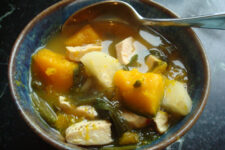Acorn squash is one of the more popular types of winter squash. It’s medium in size and typically has a dark green, ridged outer layer with a beautiful yellow color inside. Nutty and sweet, acorn squash is a tasty addition to many dishes, like roasted stuffed acorn squash.

If you’ve ever prepared acorn squash, you may have wondered if you could reduce the preparation time by leaving the skin on. Learn more about the nutritional qualities of acorn squash and whether or not it’s safe to eat the skin below.
Acorn Squash Nutrition
Like other winter squash varieties, acorn squash is incredibly nutrient dense. It is rich in vitamins and minerals, fiber, and beta-carotene.
Many of these compounds are anti-inflammatory and have health benefits like reducing the risk of macular degeneration and boosting heart health (1).
One cup of cubed acorn squash contains (2):
- 115 calories.
- 2.3 g protein.
- 0.3 g fat.
- 30 g carbohydrates.
- 9 g fiber.
- 90 mg calcium.
- 2 mg iron.
- 896 mg potassium.
- 22 mg vitamin C.
Can You Eat Acorn Squash Skin?
Yes, you can eat the skin of acorn squash, which makes it both easier to prepare and boosts the nutritional content of this popular winter squash.
Not only does leaving the skin on save valuable prep time in the kitchen, but it also has environmental impacts by reducing food waste.
Next time you prepare an acorn squash, try leaving the edible skin on to enjoy a slightly different texture and reap the nutritional benefits.

Explaining the Edibility of Acorn Squash Skin
While the skin of all winter squash is technically edible, some vegetables like pumpkins, butternut squash, and spaghetti squash have tough, thick skin, which does not soften enough during the cooking process to be enjoyable.
Options like acorn squash or delicata squash have thinner skin, softening nicely after roasting and becoming an appropriate texture. Remember, the longer you cook the squash, the softer the skin will become.
Nutritional Value Of The Skin
By eating the skin and flesh of acorn squash, you’re increasing your dish’s nutrient density and potential health benefits.
Most vegetables contain many nutrients in their outer layer, and acorn squash is no exception. The skin of acorn squash is rich in vitamins and minerals, insoluble fiber, and beneficial plant compounds like antioxidants and polyphenols (1, 3).
Tips for Preparing and Cooking Acorn Squash With The Skin
The first step in preparing acorn squash with the skin is to wash it thoroughly, then cut it into small wedges before cooking so the skin can soften properly.
Cleaning and Washing The Skin
Begin by washing your hands with soap and water. Then, place the acorn squash under running water while you scrub the outer layer with a clean brush. Pat dry with a clean cloth before cutting.
Even if you plan to peel the acorn squash before cooking it, it’s still important to wash the vegetable to prevent any dirt and bacteria on the surface from touching the inner flesh when you cut it open (4).
Roasting or Grilling Techniques
After you wash and dry the acorn squash, cut it in half from stem to bottom, then scoop out the seeds with a spoon.
Next, slice the squash into wedges. While you can roast or grill the halves, it will take longer to cook than cutting them into smaller wedges.
If you find the skin is still too tough to eat after cooking, try cooking it at a lower temperature for longer to help it fully soften.

Health Benefits of Consuming Acorn Squash Skin
With its dense nutrient content, it’s no surprise that acorn squash skin may provide promising health benefits. From its rich fiber content to antioxidant properties, you’ll never want to throw away acorn squash skin again.
High Fiber Content and Its Impact On Digestion
Like other fruits and vegetables, acorn squash skin is an excellent fiber source. Dietary fiber is a type of carbohydrate that is resistant to digestion and has numerous health benefits (3).
Fiber helps slow down digestion, improving the glucose and insulin response after eating. It can also help lower cholesterol levels, reducing the risk of heart disease.
In addition, fiber is important for gut health. A high-fiber diet can increase the levels of beneficial gut bacteria and decrease the risk of colon cancer (5).
Antioxidant Properties and Potential Disease Prevention
The skin of acorn squash is rich in antioxidants and beneficial plant compounds called polyphenols. These have been shown to have anti-inflammatory benefits and protect the body against damaging oxidation, which may reduce the risk of chronic diseases like heart disease and cancer (1).
In addition, the polyphenols in the squash skin inhibit the action of an enzyme in your body called α‐amylase. This process helps slow down the breakdown of carbohydrates and can result in lower blood sugar levels after eating acorn squash skin (1).
Precautions and Considerations
Overall, acorn squash skin is safe for most people to eat after cooking and boosts the nutritional content of the vegetable. However, there are a few precautions to keep in mind.
Digestive Conditions
Because of the high fiber content of acorn squash skin, you may need to avoid eating it if you have specific digestive conditions. For example, people with irritable bowel disease and diverticulitis may need to limit highly fibrous foods during a flare-up.
Wax Coating
Some winter squash found at the grocery store may be coated in edible food-grade wax. If your acorn squash looks extra shiny, this may be the case. Thoroughly washing and scrubbing your squash should remove this layer, making consuming the skin more enjoyable.
Consider purchasing acorn squash from a farmer’s market or growing it yourself if you find this bothersome.






